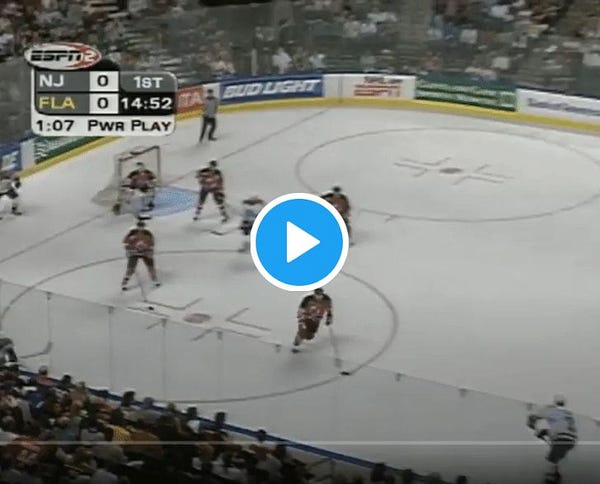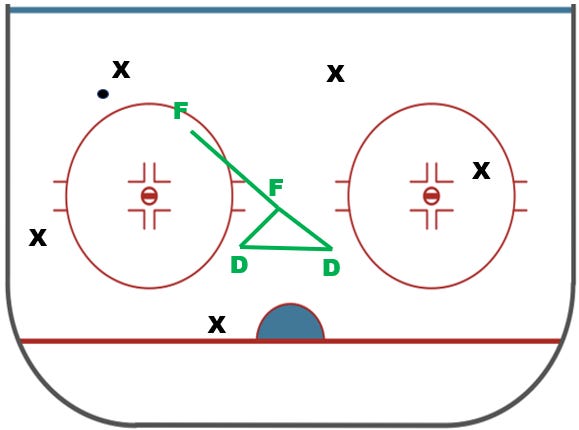Corey Sznajder posted an old NJD vs FLA clip today, which I retweeted with the rather dismissive caption: “The Diamond PK. RIP.”
Though I don’t spend much time thinking about 4v5 play, I am fairly certain that the 1-2-1 Diamond shape is a totally outdated way to defend shorthanded.
Even properly coached and executed by strong defensive players, the Diamond simply isn’t a very good geometric solution to the problem(s) posed by most modern powerplay formations.
Diamond (1-2-1)
How to set up:
High F plays the D-to-D pass at the point
Strong-side D covers the SS half-wall
Net-front D protects the crease & the back post
Weak-side F protects against seam plays & covers the WS half-wall
Strengths:
Allows for quick pressure on both half-walls
Net-front D can box out & prevent screens/tips
Weaknesses:
High F, SS D & WS F all need to move every time the PP passes the puck
Three moving parts = more open seams against quick passing
Minimal coverage against a middle bumper threat (1-3-1 PP)
If the PP sends their weak-side D into the middle of the Diamond and that player can get a quick touch on the puck, all hell is going to break loose.
For a more detailed description of the Diamond, featuring ample video clips and hand-tracked statistics, check out Bailey Johnson’s recap of U. of Michigan’s (mediocre) 2018-19 PK.
Passive Box (2-2)
How to set up:
Zone coverage rather than man-on-man
Both Fs cover the Ds when the puck is high
Ds hold their ground and protect the slot when the puck is low
Strengths:
Essentially zero moving parts
Players shift & adjust their positions as the puck moves but generally keep the same spacing.
Both Ds are available to collapse & protect the crease on net-front pucks
Weaknesses:
Minimal puck pressure when puck is on the perimeter
PKers can be coached to play a more aggressive box at the expense of slot and seam coverage.
Minimal coverage against a middle bumper threat (1-3-1 PP) & against seam plays
The Box is as vulnerable to the middle bumper as the Diamond, but is even more prone to giving up seam plays between the F and D layers.
In recreational hockey where 1) there isn’t much time to practice PK tactics and 2) offensive players aren’t adept at moving the puck in-zone, the Box is a good, simple solution.
However at the Midget AAA level and beyond, or against a well-run 1-3-1, the Box comes up a bit short.
Triangle + 1 (1-1-2)
How to set up:
Top F plays 1v3 and either provides token pressure, or aggressively hunts the puck (Czech Press)
Bottom F protects the high slot & is ready to switch with Top F if the puck goes D-to-D
Ds protect the slot
Strengths:
The “+1” covers the three lowest-percentage PP threats
The “triangle” provides 3v2 overload coverage in the slot
Weaknesses:
Requires extensive coaching and speedy/smart players
The interchange between the two Fs is a tricky thing to master. Go too late and the PP has free rein to control the puck. Go too early and space opens up for the bumper and weak-side one-timer threats.
Minimal counter-attack potential
With only one F pressing and three other skaters sitting back, it would take an extraordinary individual play for the short-handed team to go down the ice and score - which I suppose isn’t a prime concern in most 4v5 situations.
The 1-1-2 Triangle + 1 is the PK structure of choice for the vast majority of NHL teams.
It’s simply the most appropriate answer to the question: “How do we keep the puck out of the high-danger area when playing 4v5?”
However whenever a tactical equilibrium is reached, there is an opportunity to capture value by disrupting the status quo.
Return of the Diamond
Consider the following situation:
Your team is down by one or two goals in the third period
The other team is on the powerplay, but is playing tentatively
You have a number of fast, skilled forwards at your disposal who wouldn’t normally see the ice at 4v5
Why not deploy three Fs and one D in our bad, old Diamond formation?
Both strong-side Fs pressure the puck to force turnovers while the weak-side F tries to anticipate any cross-ice feeds. The lone D covers net-front but is ready to channel Devon Toews and jump early for loose pucks.
You might get scored on immediately. And you’ll definitely get scored on more often over the course of a season. But if all you need is a short-handed goal to change the entire complexion of the game, why not?
Are you a hockey nerd?
If you enjoy this newsletter and want to see more free content, consider ordering a copy of my e-book Hockey Tactics 2020, edited by a Hall-of-Fame journalist and illustrated by an artist whose work you have surely already seen. Six chapters, more timely insights, more timeless principles. Get It Now







